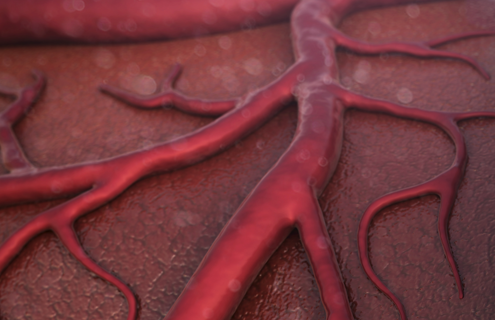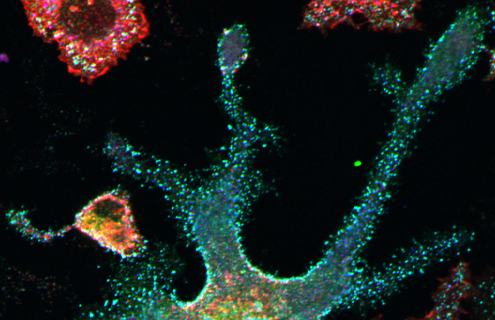

Cardiovascular disease
Cardiovascular diseases are the leading cause of death worldwide. While prevention initiatives and therapeutic advancements have successfully reduced the mortality related to these diseases, the cardiovascular disease burden remains high. Much is still unknown about the pathophysiological basis of cardiovascular disease and the differences seen between genders, age groups, and ethnicities. To gain a better understanding of these diseases, innovative approaches and authenticated cell models are essential.
Discover More
Immune system disorders
The immune system is the human body’s first line of defense against invading microbial pathogens and foreign bodies. When the immune system doesn’t function properly, it puts the body at serious risk for infection and tissue damage. The known disorders of the immune system span a vast array, ranging from those that cause deficiencies such as HIV and primary immune deficiency disorders to those that cause hyperactivity such as autoimmune diseases or sepsis. To gain a better understanding of these disorders, researchers need access to reliable models representing key immune cells.
Explore MoreWhen studying a disease, gaining an in-depth understanding of the underlying cause of the illness and how it affects the human body is essential for making progress toward combatting it. However, due to the complex nature of many diseases, this task is often not straightforward. Take cancer, for instance—it is not one but thousands of diseases. Cancer types can vary significantly in where in the body they originate, their genetic makeup, and how they progress. Because of these differences, researchers need access to a wide variety of model systems representing the various forms of the disease.
The generation of genetically engineered models and the availability of patent-derived models have helped better our understanding on the diverse nature of cancer. The advent of CRISPR/Cas9 gene-editing technology, for example, has enabled the generation of site-specific mutations in cell lines. With this technology, cancer researchers can make precise changes to the genome to produce advanced biological models that are both biologically relevant and biomarker specific. This has not only improved our knowledge on individual cancer types but has facilitated the identification of effective therapeutics. Similarly, the availability of next-generation 2D and 3D patient-derived models has proven invaluable to the research community. These models better recapitulate the in vivo tissue phenotype than traditional cell models and provide the preclinical tools needed to predict therapeutic outcomes.
Cancer Research
Cancer is not one disease but thousands. The multifaceted nature of cancer has been a significant challenge toward the development of effective treatment options and understanding the underlying causes of the disease. While existing in vitro models have significantly improved our understanding of cancer, they are frequently limited by a lack of complexity and diversity. Advanced biological models such as 2D and 3D patient-derived models and CRISPR/Cas9 genome-edited cells help solve some of the issues associated with current cancer models while providing a better understanding of disease progression and population diversity.
Learn MoreLike genetic disease research, infectious disease research is also not without its own set of challenges. One of the most prominent global health threats facing the world today is the emergence and spread of antimicrobial resistance among microbial pathogens. The overuse and misuse of antimicrobials has accelerated the emergence of new forms of resistance, which are now threatening our ability to treat common infectious diseases. To address this growing problem, the research community is working toward developing better diagnostic tools that enable the more targeted use of antibiotics.
To develop these diagnostic tools, it is essential to understand the underlying genomics behind antimicrobial resistance. However, this can be challenging as there are numerous mechanisms contributing to drug resistance and variants within those. This is further complicated by the fact that microbial strains can harbor numerous resistance genes. So, much like cancer research, scientists need access to a variety of clinically relevant pathogens that represent the diverse and complex nature of drug resistance. The availability of globally sourced multidrug-resistant strains provided with source metadata, genetic data, and susceptibility profiles have helped make this possible. With whole-genome sequencing data, researchers can identify possible antimicrobial resistance genes and examine how these tie back to the susceptibility profile. These findings can then lead to the development and implementation of more accurate diagnostic tools.
Infectious Disease
Despite their small size, pathogenic microorganisms have dramatically shaped human life. Throughout history, epidemics and pandemics have affected population sizes, caused economic struggle, and changed our daily habits. Even years or centuries later, the impact of many devastating diseases still echo throughout society. The continual emergence and spread of infectious pathogens underscore the importance and need for effective prevention and treatment methods, epidemiological tracking, and transparent communication across the globe. Discover how you can help.
Discover NowRegardless of the type of disease, one thing is for certain: understanding what causes a disease and how it affects the human body is essential for developing improved treatments and diagnostics. Through the hard work of researchers and clinicians, we are getting closer every day to improving the health and well-being of people throughout the world. At ATCC, we strive to empower the life science community with the advanced biological models and clinically relevant strains needed to support this critical research.
